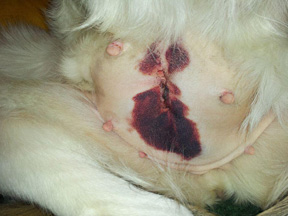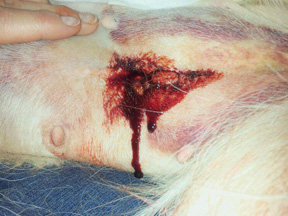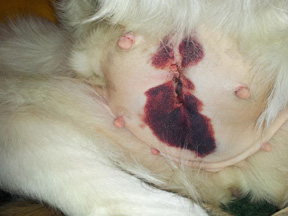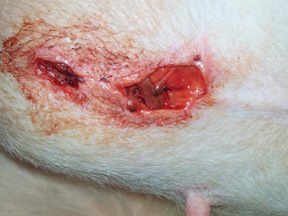
Traverse City's Spay-Neuter Express Event Leaves Some to Question the Veterinarian's Past and Current Actions
In May of 2012, the Spay-Neuter Express out of Lowell came up to Traverse City to do a low-cost spay/neuter clinic that was hosted by Handds to the Rescue and Joey & Frisco's Mission. These two non-profit groups made residents aware of the services available and volunteered to help get supplies and with some of the logistics of the event.
The staff on the Spay-Neuter Express bus included veterinarian, Dr. Bruce Langlois, and two vet assistants. The Spay-Neuter Express was in town for two days.
Soon after the event, I received reports of a dog who was suffering from the spay that was done in the Traverse City Spay-Neuter Express mobile unit. The dog, Daisy, is a two-year old St. Bernard owned by Carrie Donald.

The photos below show what Daisy looked like after her spay.




Because of Daisy’s bleeding, Carrie called the cell phone of Dr. Langlois and didn't get any answers. His office called her back but said they had no appointments until Monday even though Carrie mentioned Daisy's bleeding. Carrie decided to call her own vet and took Daisy in to see him immediately. Her vet told her that the dog had been butchered on the inside. The dog was a hemophiliac and Carrie’s vet felt that Dr. Langlois should have known that when he did the surgery. Hemophilia refers to a group of bleeding disorders in which it takes a long time for the blood to clot. Carrie’s vet said that three bleeders were left un-cauterized and there was bleeding into the stomach which led to the dog’s belly swelling. Daisy had to undergo surgery with Carrie’s vet to repair the damage and some of that work included a drain tube to remove infection and several laser treatments. Although Daisy is doing much better now, the dog has lost a lot of weight from the ordeal. When Daisy received her spay, she was 98 lbs. and she is now 72 lbs. In addition, Carrie had to pay her own vet about $1200 so that Daisy could be taken care of and be brought back to health.
When I asked Dr. Langlois if he was contacted by any pet owners who had problems in Traverse City and what he knew of the circumstances, he gave a general answer not relating to Carrie calling his office. He said, “we get about 1-2 calls per day that the mobile is out, and the calls are typically about things such as nauseousness or drowsiness or similar typical concerns owners have after surgery.”
When I showed the photos of Daisy to other local vets in the Traverse City area, they concurred that the photos did not look “normal.”
After contacting other vets in Traverse City, I found at least two other pets who had complications from their visit to the Spay Neuter Express. A local vet said one female pet had a very swollen and inflamed spay incision. The other pet had a very swollen scrotum with an inflamed incision. This vet said that the circumstances could be due to various causes including the owner not keeping the pets quiet and still; excessive licking by the pet or a lack of owner compliance.
In addition to those three pets having issues from the Spay-Neuter Express, one cat died. That cat was FELV and FIV positive and died after recovering from anesthesia and surgery. According to Dr. Langlois, they did not do an autopsy to determine the cause at the owner’s request.
According to the local organizers of the The Spay-Neuter Express event, Dr. Langlois spayed and neutered 53 dogs and 41 cats when he was in Traverse City. Dr. Langlois said his cat spays average about 4 minutes; cat neuters about one minute; dog spays about 8-10 minutes and dog neuters about 4-5 minutes. Dr. Langlois operates a full service hospital in addition to the Spay-Neuter Express. He personally did 10,000 to 12,000 spay/neuters with the mobile unit last year.
He stated that he does not take bloodwork before performing surgery on pets on the Spay Neuter Express and he does not offer it. He said it is extremely rare that those findings would make a difference in whether or not a procedure is performed. If someone prefers bloodwork, he would suggest they go to a full service hospital. When a pet is getting a spay or neuter on his mobile unit, they receive a form which asks them specifically if their pet has had any prior health problems.
After learning about local pets having complications with the Spay Neuter Express, I looked up Dr. Langlois license with the State of Michigan and found many things listed over the years pertaining to that license. I did a FOIA on the reports and this is what I found:
Dr. Langlois’ most recent Consent Order and Stipulation on his veterinary licenses is dated February 2012. In the orders I have reviewed, Dr. Langlois does not admit nor deny allegations of fact and law set forth by the complaint but the Disciplinary Subcommittee of the Michigan Board of Veterinarian Medicine treats the allegations as true for purposes of their Consent orders. Dr. Langlois has been ordered several times, and is on probation now, to adhere to the stipulations of the Subcommittee, including things such as meeting with a board member bi-annually, having 10 random cases reviewed at this meeting (10 others chosen by the vet) and continuing education credits in addition to other stipulations.
The following is a summary of the complaints against Dr. Langlois, as well as Consent Orders and other documentation provided by the Michigan Board of Veterinarian Medicine. Although you might find this information to be lengthy, it is a condensed version of the multiple documents provided by the State of Michigan.
• On February 7, 1996, the Department filed an Order of Summary Suspension and an Administrative Complaint against Respondent based on his conviction for Criminal Sexual Conduct 4th Degree. On May 30, 1996, the DSC issued a Consent Order and Stipulation dissolving the Order of Summary suspension and suspending Respondent's license for a minimum of six months and one day.
• On March 5, 1997, the Department issued an Administrative Complaint alleging that Respondent practiced veterinary medicine while his license was suspended. During this time, Respondent had also filed a Petition for Reinstatement. Both patters proceeded to an administrative hearing. On October 19, 1998, the board issued a Final Order suspending Respondent's license for a period of six months and one day.
• On May 26, 2000, the Board issued a Final Order Granting Reinstatement granting Respondent a limited license to practice under general supervision for a minimum period of three years. the Board also placed Respondent on probation with terms. On November 19, 2004 the Board issued an Order Granting Reclassification giving Respondent a full and unlimited license to practice veterinary medicine.
• On October 1, 2008, the Department filed an Administrative Complaint against Respondent based on Respondent's performance of remote area medical event surgeries on approximately 200 cats and dogs without maintaining records of controlled substances used and administered, and his failure to adequately sterilize the surgical instruments. On May 28, 2009, the DSC issued a Final Order pursuant to a consent agreement placing Respondent on probation for a period of six months with terms including a requirement Respondent comply with all applicable provisions of the code.
• The Administrative Complaint dated April 12, 2011 replaces the Complaint previously filed on February 17, 2011 and includes the following counts:
- Since May 2009, Respondent, who does not hold a pharmacy manufacturing license, has been manufacturing a solution to mimic the federal FDA veterinary-approved product, Yohimbine. Respondent is manufacturing the solution from pharmaceutical ingredients that are not approved by the FDA and then injecting the solution into cats and dogs immediately following surgery to reverse the effects of Xylazine, a drug veterinarians use as an anesthesia in animals. The solution that Respondent manufactures is not FDA approves. Respondents conduct as described above constitutes negligence and incompetence in violation of Codes 16221(a) and 16221(b)(i).
- In May 2009, Respondent performed spays and neuters on multiple cats placed side-by-side on the operating table. Occasionally during the procedure, the cats would come in contact with one another, compromising the sterile environment.
- In his November 4, 2009 interview with Department Investigator Sergio Grijalva, Respondent admitted that there were occasions during spay and neuter clinics when he lined up cats on an operation table during surgery and that the cats would be placed close enough together as to be almost touching. He also stated that although he changed gloves and instruments before moving from one cat to another, he did not wash his hands in between procedures. The Respondent's conduct as described above constitutes negligence and incompetence in violation of Codes 16221(a) and 16221(b)(i).
- On October 29, 2009, Respondent performed a neuter procedure on Mak, a four-year-old male Newfoundland from Great Pyrenees Rescue, an animal rescue program operated by Marcie Tepper. As part of the procedure, Respondent placed a blue compression bandage around Mak's scrotum to prevent swelling following the neuter procedure. Respondent did not remove the compression bandage. Following the procedure, an employee from Great Pyrenees Rescue transported Mak from Respondent's office to Lansing, Michigan where a foster volunteer was waiting to transport him to her home.
- On October 31, 2009, the foster volunteer took Mak outside for a walk. When Mak lifted his leg up to urinate, the volunteer noticed that his scrotum was purple in color and swollen to the size of a baseball. The volunteer immediately called Ms. Tepper to advise her of Mak's condition. Ms. Tepper then called Respondent to inform him what the volunteer had reported and indicated that Mak needed to see a veterinarian. Respondent advised Ms. Tepper that Mak did not need to see a veterinarian as swelling was normal and that she should have the foster volunteer call him if there were any further problems. In a May 13, 2010, interview with Investigator Grijalva, Respondent stated that he did not remember having this conversation with Ms. Tepper.
Instead of calling Respondent, the foster volunteer had her daughter take Mak to the Gasow Veterinary Clinic near her home so that the dog could receive immediate care. Myda Korkigian-Fisher, DVM, was the attending vet at Gascow when Mak was brought in on October 31, 2009. Dr. Korkigian-Fisher found blue surgical wrap tied around the base of Mak's scrotum which had caused the scrotum to swell and the tissue at the base of the scrotum to become necrotic. As a result, Dr. Korkigian-Fisher had to perform a scrotal ablation to remove the rotted tissue.
In his interview with Investigator Grijalva, Respondent admitted that he used a blue compression bandage during Mak's neuter procedure to keep the scrotum from filling with fluid following the surgery. He indicated that his veterinary technicians must have forgotten to remove the compression bandage following the procedure and that had they done so there would have been no need for the scrotal ablation.
- On July 6, 2010, Respondent provided Investigator Grijalva with records and documents pertaining to Mak's care. The records were missing the pre-operative assessment, the operative report, a list of drugs administered, a time of placement and removal of compression bandage, and a record of any controlled substances used. Essentially, Respondent provided no records of this surgical procedure, which is below the standard of care. Respondent's conduct as described above constitutes negligence and incompetence in violation of Codes 16221(a) and 16221(b)(i). and also a board order that was issued.
- In November of 2009, KF took her Airedale Terrier, Copper, to the Grand River Veterinarian Hospital in Lowell to be neutered. Prior to performing the neuter procedure, Grand River staff obtained pre-procedure blood work from Cooper. Following the neuter procedure, one of the staff members informed KC that the blood test results suggested that Copper was anemic and may be suffering from a kidney disease. Later in the day on January 27, 2010, KF brought Copper to Respondent's office. At that time, Respondent conducted a urinalysis which indicated that Copper had increased protein levels. Increased protein levels suggest the presence of kidney disease.
Respondent indicated on Copper's second January 27, 2010 Examination Report Card that blood and urine results were consistent with intestinal parasites. Therefore, Respondent placed Copper on Doxycycline, Drontal and Metronidazole, a broad spectrum of de-worming agents. Respondent indicated in his December 13, 2010 interview with Investigator Grijalva that he chose this course of action after a phone consultation with an internist at Antech Diagnostics of Oakbrook, Illinois. However, there is no record of this consultation or of the internist's recommendation. Additionally, Respondent was unable to provide Investigator Grijalva with the internist's name.
Respondent also noted on Copper's Examination Report Card that Copper weighed 44.5 pounds, however, there is no other documentation to indicate that Respondent conducted a physical examination of Copper during this visit.
- On February 26, 2010, KF brought Copper to Respondent's office for a follow-up visit. Respondent documented on Copper's February 26, 2010, Examination Report Card that during Copper's visit he conducted a physical exam and a feces test. The feces test was negative, which indicates only that there were no parasite eggs in Copper's feces. In addition, the documentation in the Examination Report Card reflects that Copper weighed 42 pounds, which is 2.5 pounds less than his previous visit a month earlier. Despite Copper's weight loss and the previous test results, which suggested the presence of kidney disease, Respondent indicated on the Examination Report Card that Copper was healthy and "good to go for obedience class."
- On May 26, 2010, Copper suffered a seizure. KF immediately brought Copper to Respondent's office. Respondent ran a series of tests and determined that Copper was suffering from renal failure, end stage. As a result, Respondent had to euthanize Copper. Respondent's conduct as described above constitutes negligence and incompetence in violation of Codes 16221(a) and 16221(b)(i).
• On February 23, 2012, a Consent Order was issued. This order confirmed the previous second superseding administrative complaint and stipulates that the parties may enter this consent order. It further states that the Disciplinary Subcommittee has reviewed the stipulation contained in this document and agrees that the public interest is better served by resolution of the outstanding complaint. Therefore, the Disciplinary Subcommittee finds that the allegations of fact contained in the complaint are true and the Respondent has violated sections 16221(a), (bI(i) and (h) of the Public Health Code and 1996 AACS R 338.1632.
In the Consent Order, they ordered that the Respondent is placed on PROBATION for a period of one year commencing on the effective date of this order. Respondent shall be automatically discharged from probation at the end of the probationary period provided Respondent has complied with the terms of this order. The terms and conditions of the probation, which Respondent must complete within a period of probation which includes to meeting with a Board member, having Record Reviews, continuing education credits, paying a $250 fine and more.
It was further stated that any violation of the Public Health Code by Respondent during the period of probation shall be deemed a violation of probation and constitute grounds for further disciplinary action.
The Respondent did not contest the allegations of fact and law in the complaint. It stated that the Respondent understands that by pleading no contest, he does not admit the truth of the allegations but agrees that the Disciplinary Subcommittee may treat the allegations as true for resolution of the complaint and may enter an order treating the allegations as true. The Respondent understands that by signing the stipulation, he is waiving the right, under the Public Health Code, to require the Dept. to prove the charges set forth in the complaint by presentation of evidence and legal authority and to present a defense to the charges before the Disciplinary Subcommittee or its authorized representative.
At the end of this Consent order, it states that the parties considered the following factors in reaching this agreement:
- During the compliance conference, Respondent indicated that he believed he was compounding Yohimbine within FDA guidelines. However, as a result of these allegations, Respondent has stopped compounding Yohimbine and now uses other FDA approved products.
- The allegations contained in one of the Counts are inaccurate. While Respondent does occasionally conduct cat neuters by lining up multiple cats on a surgical table, he does no conduct spays in this manner. further, when he is conducting multiple neuters, he uses a new sterile blade for each cat and changes his gloves between each procedure. In light of his new information, Dr. Rohwer did not believe Respondent's conduct was a violation of the Code.
- As to another Count, Respondent explained that he had instructed one of his assistants to remove the compression bandage from Mak's scrotum and that she failed to do so. However, Respondent acknowledges that he was ultimately responsible for Mak's treatment and takes full responsibility for the failure to remove the bandage.
• During the compliance conference, Respondent explained that his treatment of Copper was complicated by KF's hesitancy to pay for the additional tests necessary to rule out kidney disease. Further, based on the information Respondent provided at the compliance conference, AAG Smith was able to confirm that Respondent conducted phone consultation with an internist from Antech Diagnostics and treated Copper according to the court of treatment recommended by the Internist. Respondent believes that he provided Copper with the best treatment possible given the circumstances.
• Respondent was open and honest during the compliance conference and fully cooperated in resolving this matter.
It was further learned that Dr. Langlois was removed from a spay neuter event in October of 2011 at the Allegan County Area Technical and Education Center because he is on the Michigan Public Sex Offender Registry, which prohibits sex offenders from working, living or loitering within 1,000 feet of a school. You can read the article here.
After reviewing all information, I contacted Dr. Langlois for further clarification and additional questions. When asked about his history of complaints with the State and how he assures his clients that their pets are in good hands, this is what he had to say: “I have done over 100,000 surgeries and in doing so have become extremely proficient. I have requests and I travel across the US and the world training students and veterinarians on proficient surgery techniques. Also, because, I perform so many procedures and have become so proficient at it, Our rate of complications is much lower then at the vast majority of hospitals. If you were having a procedure done on yourself, would you rather have a doctor that has done over 100,000, or go to a doctor that has done less then 2-300? Shouldn't you feel the same way about your pet? Because I do so many procedures and I am doing them across the state, I run across some that feel threatened by our services. When I do 15000-20000 procedures per year, and the average doctor does less then 50, I have a much greater exposure to complaints. We have all come across people who love to complain, and those who are jealous of our skills. When I do 300x the procedures that they typical doctor does, no matter how good of a job I do, I have 300x the possibility of having a complaint filed. Even though I do so many procedures, I perform each one as if it were my own pet, and give it each procedure the attention and detail it deserves.”
Pet Friend Magazine Note: Like choosing their own vet for their personal pets, it is recommend that rescue groups, communities and pet owners using new vets they are not familiar with inquire about the veterinarians they are thinking of working with. Pet owners and rescue groups can find out if a veterinarian has complaints against their license by going to this website: here. It would also be useful to get references from other vets, rescue groups and clients who have used that veterinarian.
If you would like a copy of the full reports from the FOIA request, please email me here.